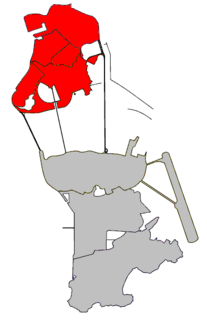Related Research Articles

Caldas da Rainha is a medium-sized city in western central Portugal in the historical province of Estremadura and the district of Leiria. The city serves as the seat of the larger municipality of the same name and of the Comunidade Intermunicipal do Oeste. At the 2011 census, the municipality had a population of 51,729 in an area of 255.69 square kilometres (98.72 sq mi), with 27,378 residing in the city. Although the city itself lies about 10.5 kilometres (6.5 mi) inland, three of the municipality's civil parishes lie on the Atlantic Ocean. Caldas da Rainha is best known for its sulphurous hot springs and ceramic pottery.

Nossa Senhora do Pópulo is a former civil parish in the municipality of Caldas da Rainha, Portugal. In 2013, the parish merged into the new parish Caldas da Rainha — Nossa Senhora do Pópulo, Coto e São Gregório. The civil parish has an area of 12.00 square kilometres (4.63 sq mi) and had a population of 16,114 at the 2011 census.

Serra do Bouro is a former civil parish in the municipality of Caldas da Rainha, Portugal. In 2013, the parish merged into the new parish Caldas da Rainha — Santo Onofre e Serra do Bouro. The civil parish had an area of 18.21 square kilometres (7.03 sq mi) and had a population of 703 at the 2011 census. It the least populous freguesia of the municipality.

Freguesia, usually translated as "parish" or "civil parish", is the third-level administrative subdivision of Portugal, as defined by the 1976 Constitution. It is also a local administrative unit in the former Portuguese overseas territories of Cape Verde and Macau. In the past, was also an administrative division of the other Portuguese overseas territories. The parroquia in the Spanish autonomous communities of Galicia and Asturias is similar to a freguesia.
Concelho, is the Portuguese-language term for municipality, referring to the territorial division. In comparison, the word município refers to the organs of State. This differentiation is still in use in Portugal and some of its former overseas provinces, but is no longer in use in Brazil following the abolition of these organs, in favour of the French prefecture system.

Salir do Porto is a former civil parish in the municipality of Caldas da Rainha, Portugal. In 2013, the parish merged into the new parish Tornada e Salir do Porto. The civil parish has an area of 9.86 square kilometres (3.81 sq mi) and had a population of 797 at the 2011 census.

A câmara municipal is a type of municipal governing body, existing in several countries of the Community of Portuguese Language Countries.
An Assembleia Municipal is the legislature that governs a municipality in Portugal. Part of the assembly's members are elected every four years among candidate lists by the D'Hondt method, simultaneously with the election of the Câmara Municipal; the remainder member are the presidents of the Junta de freguesia that compose the municipality, whose number cannot exceed the number of elected members. A municipal assembly generally meets five times a year, and its members are paid a presence fee for each meeting.

The councils and assemblies of the municipalities of Macau were abolished on 1 January 2002, and their functions transferred to the Instituto para os Assuntos Cívicos e Municipais, slightly more than 2 years after Macau became a special administrative region (SAR) of the People's Republic of China. They had been put in place under the administration of Portugal. In 2019, the Instituto para os Assuntos Cívicos e Municipais was replaced by the Instituto para os Assuntos Municipais.

The Municipality of Macau was one of the two municipalities of Macau, along with the Municipality of Ilhas. Its bodies were the municipal council and the municipal assembly. Per Law No. 17/2001, the two municipalities were abolished on December 31, 2001 and replaced by the Instituto para os Assuntos Cívicos e Municipais the following day.

The territory of Cape Verde is divided into 22 concelhos (municipalities), and subdivided into 32 freguesias.

The Azores Regional Election (1976) was an election held on 27 June 1976 for the first Legislative Assembly of the Portuguese Autonomous Region of the Azores.

Aguada de Baixo was a freguesia in Águeda Municipality, Aveiro District, Portugal. It had an area of 4.7 km2 and in 2011 had a population of 1373. In 2013 it was merged with Barrô as part of an administrative reorganization of the territory and formed the União das Freguesias de Barrô e Aguada de Baixo.

The junta de freguesia is the executive body of a freguesia, a subdivision of each municipality of Portugal. The laws regulating the juntas de freguesia are Lei n.o 169/99, de 18 de Setembro and Lei n.o 5-A/2002 de 11 de Janeiro. Each junta has a President.

Águeda e Borralha is a freguesia in Águeda Municipality, Aveiro District, Portugal. The population in 2011 was 13,576, in an area of 36.03 km².

Barrô was a freguesia in Águeda Municipality, Aveiro District, Portugal. It had an area of 7 km2 and in 2011 had a population of 1836.

Águeda was a freguesia in Águeda Municipality, Aveiro District, Portugal. It had an area of 41.6 km2 and in 2011 had a population of 11,346.

Belazaima do Chão was a freguesia in Águeda Municipality, Aveiro District, Portugal. It had an area of 19.8 km2 and in 2011 had a population of 599.

Comunidade Intermunicipal do Oeste is an administrative division of Portugal, located on the country's western central coast. The population in 2011 was 362,540, in an area of 2,220.16 km². Caldas da Rainha serves as the seat of OesteCIM.

Borralha was a freguesia in Águeda Municipality, Aveiro District, Portugal. It had an area of 9.6 km2 and in 2011 had a population of 2230.
References
- ↑ Assembly of the Republic (28 January 2013). "Lei n.o 5-A/2002 de 11 de Janeiro" (PDF). Diário da República (in Portuguese). Retrieved 31 January 2014.
- ↑ Associação Nacional de Freguesias. "FREGUESIA - ÓRGÃOS" (PDF). anafre.pt (in Portuguese). Archived from the original (PDF) on 1 February 2014. Retrieved 31 January 2014.
| This article about politics in Portugal is a stub. You can help Wikipedia by expanding it. |